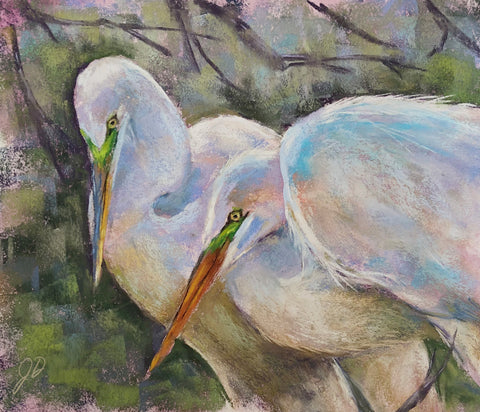Polychromos Pastel Tips and Techniques

Pastel tips, techniques, and a Egret pastel tutorial.
Pastel is an extraordinarily beautiful medium, limitless in its powers to produce breathtaking artistic expression. With its layering of pigments producing rich depth of color and exquisite painterly effects, pastel offers a vibrant luminescence unlike any other material.
Pastels have a rich history and can be traced as far back as the Renaissance Period. The medium is said to have been a favorite of the masters, including Michelangelo and Leonardo da Vinci who sketched with the only colors available at the time– black, white and red. Later after many more pigments were developed, French Impressionists such as Monet, Gauguin, Degas and Renoir, among others, turned to pastel to create many famous works of art.
In today’s art world, pastel has made a comeback, rapidly gaining popularity as artists have realized its potential as such a beautiful, luminous medium, also a unique medium requiring no mixing of colors or drying time.
A successful pastel painting foundation begins with an underpainting using Faber-Castell Polychromos Pastels. These premium quality, rich, velvety pigment sticks are very versatile due to their form. The flat sides of the stick enables the pastels to begin the underpainting by blocking in the first bold layer of color/value to later dissolve in wet underpainting techniques. The sticks’ sharp tip is perfect for drawing the fine, crisp lines and details of the painting. This is but one of a variety of expressive techniques that Polychromos Pastels lend themselves to.
Polychromos Pastels come in an extraordinary range of vibrant, lightfast, acid-free pigments, and are conveniently color-matched to all other Faber Castell Art & Graphic Products, enabling reliable mixing techniques of all artists’ materials.
These professional quality Polychromos Pastels are sold in color balanced sets including a cardboard wallet of 12 and 36 pieces, and a tin of the full range of 60 sticks.
Faber Castells’ traditional commitment to producing the highest quality art materials available insure the artist with the creative inspiration they seek for producing unique and impressive works of art.
Faber-Castell Polychromos Pastels.
Experience the pleasure of what pure quality has to offer
Tips for working with Polychromos Pastels
Choosing paper
With such a large variety of papers available to todays pastelist, it is important to explore and experiment with brands and types used for pastel. The type of paper, primarily sanded or unsanded, determines not only the experience of creating the art, but the final outcome of it.
Making corrections
A vinyl eraser will completely remove pastel color while a kneaded eraser can gently lift and lighten color
Techniques:
Shading
Polychromos pastel sticks are smartly designed with 4 flat sides to achieve even, defined stroke widths for shading and coverage. A variety of color intensities are achieved by the amount of pressure used with the stick.
Parallel Hatching / Cross Hatching
Hatching is a technique of drawing fine parallel lines close together to give the effect of shading. The closer together the lines are, the darker the area appears.
Cross hatching are hatching marks overlapped at different angles. Depending on the density of the lines and number of colors used, new tones can be created.
Mixing and Smudging
Smudging is a technique where colors are rubbed into the paper with a finger, blending stump or cloth. Soft, smooth color gradients can be created by smudging the lighter colors into the darker colors.
Blending
New tones and variations can be achieved by layering combinations of sticks, resulting in beautiful soft blends.
Brush painting under painting
Beautiful effects can be achieved with solvents like rubbing alcohol. Simply brush over blocked in shapes of color with rubbing alcohol to dissolve the pastel, turning it into a paint. This technique is ideal for creating underpaintings and backgrounds.
Creating ground pastel
Finely ground pastel pigment can be produced by rubbing pastel sticks against a sandpaper pad or scraping pigment off the stick with a Exacto knife. This technique can be useful for smudging larger areas or creating a speckled effect on a surface that has been sprayed with fixative or damp acrylic paint.
Mixed media
Interesting and creative effects can be produced when Polychromos Artists’ Pastels are combined with other media such as Albrecht Durer Artists’ Watercolor Pencils and Polychromos Artists’ Colored Pencils
How to:
Creating an underpainting
Polychromos Pastel Crayons are ideal to use for beginning a pastel painting with an exciting underpainting. An underpainting is the first layer of color applied to the paper best done with hard pastels. They are often monochromatic and help define or “map out” color values for the final painting. They can also be used to tone the paper with a color giving the overall painting a unity.
I begin by taping a piece of 500 grit sanded pastel paper that accepts a wet wash to an upright easel board. I choose to do an underpainting using magenta because I plan on this tone peeking through the painting giving it an overall unity. I lightly sketch out the egrets with a magenta pastel.

Here I loosely block in the dark, medium and light values of the image using the flat side of the pastel.

Here I apply a light wash of rubbing alcohol over the dry pastel with a soft synthetic brush. This liquefies the pastel turning it into paint. I paint in a loose, painterly manner allowing drips or unusual wet effects to occur, which could possibly add a unique look to the finished piece. An alcohol underpainting dries in about 10 minutes, and is then ready for continuing to paint layers of soft pastel.

Here, the Polychromos pastel sticks’ hard edges are ideal for painting the fine detail of the Egret’s eye.



